|
By accessing or using The Crittenden Automotive Library™/CarsAndRacingStuff.com, you signify your agreement with the Terms of Use on our Legal Information page. Our Privacy Policy is also available there. |

Authorities Threaten to Close Iconic Washington Bridge
|
|---|
|
|
Authorities Threaten to Close Iconic Washington Bridge
Esha Sarai, VOA News
14 August 2016
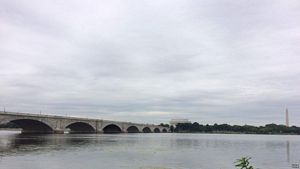 The Memorial Bridge, an iconic link between D.C. and Virginia, overlooks the Lincoln Memorial and Washington monument, Aug. 9, 2016. (E. Sarai/VOA) The Memorial Bridge, an iconic link between D.C. and Virginia, overlooks the Lincoln Memorial and Washington monument, Aug. 9, 2016. (E. Sarai/VOA)
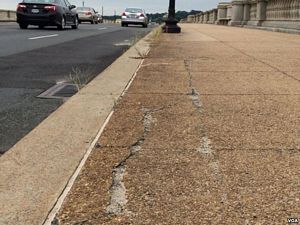 Cracks and weeds grow daily as the National Parks Service struggles to repair the Memorial Bridge, Aug. 9, 2016. (E. Sarai/VOA) Cracks and weeds grow daily as the National Parks Service struggles to repair the Memorial Bridge, Aug. 9, 2016. (E. Sarai/VOA)
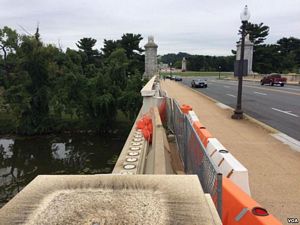 Construction on the Memorial Bridge begins after the National Parks Service received a $90 million grant to fix it this July, Aug. 9, 2016. (E. Sarai/VOA) Construction on the Memorial Bridge begins after the National Parks Service received a $90 million grant to fix it this July, Aug. 9, 2016. (E. Sarai/VOA)
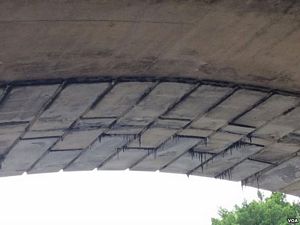 Looking out from underneath D.C.’s crumbling Memorial Bridge, Aug. 9, 2016. (E. Sarai/VOA) Looking out from underneath D.C.’s crumbling Memorial Bridge, Aug. 9, 2016. (E. Sarai/VOA)
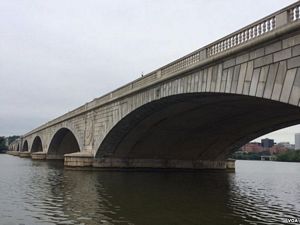 The Memorial Bridge over the Potomac river, looking West to the Arlington cemetery, Aug. 9, 2016. (E. Sarai/VOA) The Memorial Bridge over the Potomac river, looking West to the Arlington cemetery, Aug. 9, 2016. (E. Sarai/VOA)
|
WASHINGTON — A sculptured span over the Potomac River, Washington D.C.’s Memorial Bridge provides tourists and residents alike a path between two American icons – the memorial to President Abraham Lincoln and the Arlington cemetery, where more than 400,000 U.S. soldiers have been put to rest.
Tens of thousands of people drive, bike, jog, and photograph their way across the bridge daily.
But only some are aware that the stone and masonry structure is crumbling beneath them.
“I see it every day,” said Frank Lopez del Rincon as he dismounted his bike. “The cracks, people working on it…it clearly needs lots of work.”
Del Rincon has been riding his bike across the bridge daily for years.
“It’s kind of an open space by the river, and it’s very architecturally impressive – I mean you have a classic monument right here,” said the Arlington, Virginia, resident. “And I love the bridge. It’s very historic.”
K. Seyoum, a D.C. cab driver, also uses the bridge every day.
“From this area we go to the airport,” he said while driving across the bridge. “To GW Parkway… and so many people are going to the Arlington memorial so you have to go that way. The bridge is very important!”
And like Del Rincon, Seyoum has experienced first-hand the difficulties of reconstruction and lane closures, “especially during rush hour.”
Patching it up
Temporary “quick fixes” have been made on the bridge for years, and more permanent changes such as shutting down outer lanes and increasing weight limits have affected the some 68,000 commuters who use the bridge on a daily basis.
Emergency projects in 2010, 2012, and 2015 resulted in months of lane and/or sidewalk closures, yet the underfunded National Park Service (NPS), which has jurisdiction over the bridge, says those fixes were only temporary.
“The park service…they’re never going to have enough resources. So they say ‘what’s falling apart most, that needs repair quickest’,” Matthew Gilmore, local historian and urban planning expert, told VOA.
Without a complete overhaul, it estimates that the bridge will be required to close to all traffic by 2021 as the deck continues to deteriorate.
Cyclist Del Rincon was surprised to hear that NPS continues to struggle to find funding for more permanent fixes. “I would think the government would cover that.”
Though the bridge received a $90 million grant from Congress in July for repairs, an estimated total of $250 million would be required to fully restore it.
“I have no doubt they’ll get the money. You can’t really let one of the main connectors between the city and elsewhere crumble,” said Gilmore.
Deteriorating infrastructure
The situation of the Memorial Bridge is far from isolated. The American Society of Civil Engineers (ASCE) this year rated one in nine American bridges as “structurally deficient.” Progress is slow, however, because the U.S. Congress has been unwilling to budget the necessary money toward infrastructure in recent years.
According to estimates released by the Federal Highway Administration, the U.S. needs to spend nearly twice its current annual budget of $12.8 billion just to ensure American bridges stay intact.
The nation’s capital fares worst, with 77% of its bridges rated deficient (including both structurally deficient and “functionally obsolete”), according to the Infrastructure Report Card released by the ASCE.
Additionally, the White House estimates that 95% of roads in the capital are in poor condition.
The Memorial Bridge is just one of 185 bridges in the District that requires attention – and funding – to continue serving commuters.
“It’s like the metro,” Gilmore said, referring to the Washington-area public subway system which is currently under renovation but still regularly seeing derailments and delays.
“We think ‘I’ll clean that up later’… New is fun and sexy and cool. Cleaning up the old stuff isn’t as much.”
‘Avenue of heros’
Built in 1932, Memorial Bridge was designed to be a ceremonial entrance to Washington, part of an "Avenue of Heroes” that is lined with monuments to American heroes such as General and President Ulysses S. Grant and explorer Admiral Richard Byrd as well as heroic concepts like valor and sacrifice.
Gilmore, Del Rincon, and Seyoum all agree that no matter the political and monetary hurdles, the bridge will have to be overhauled.
To elaborate, Del Rincon offered a quote he erroneously attributed to former President Ronald Reagan: “When a problem gets big enough, it gets fixed.”

















